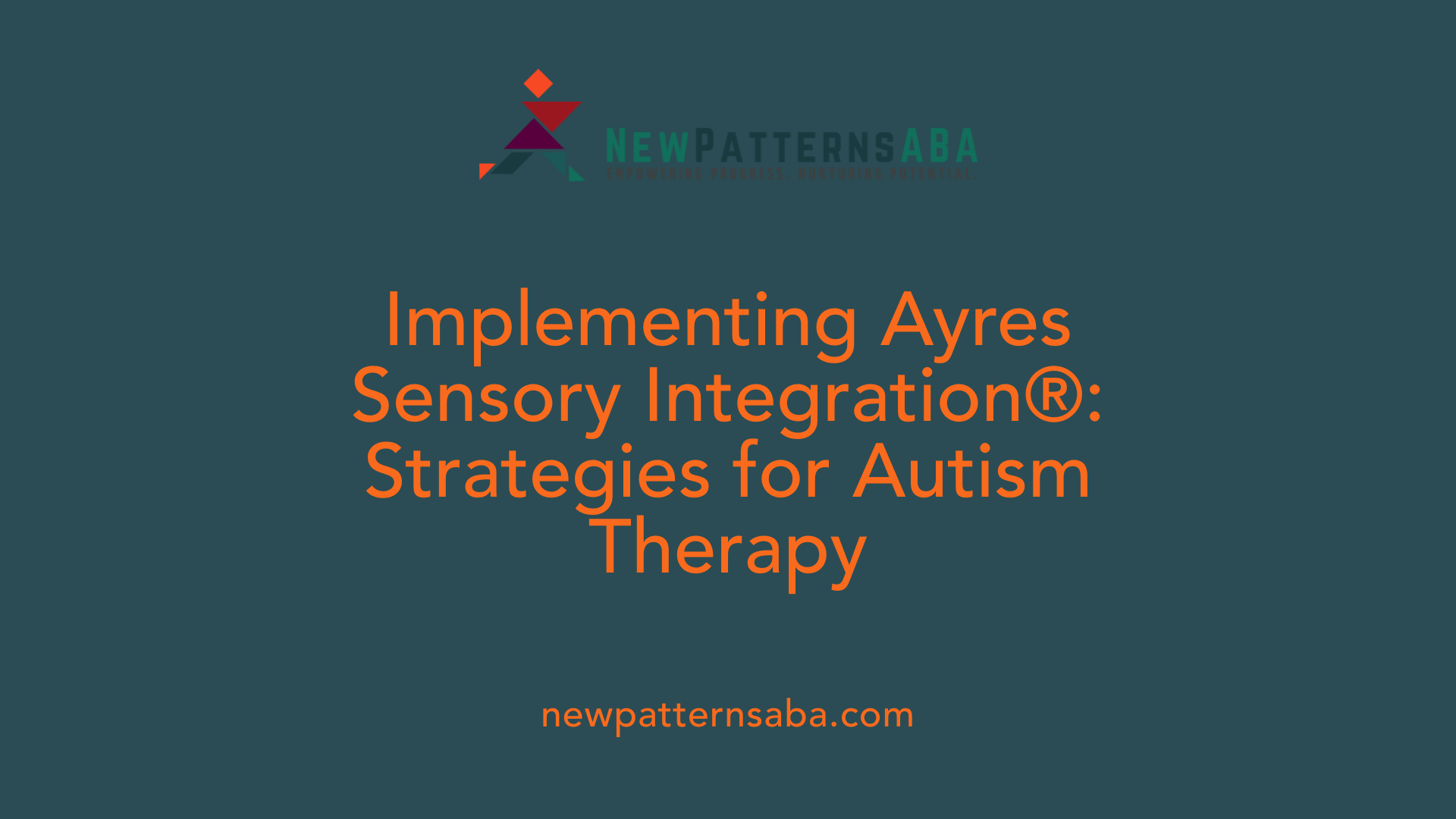Bridging Sensory Challenges and Daily Functioning: The Crucial Role of Occupational Therapy in Autism
Understanding Occupational Therapy in Autism Spectrum Disorder
Occupational therapy (OT) plays a pivotal role in supporting children with autism spectrum disorder (ASD), particularly in addressing sensory integration difficulties that can impact learning, behavior, and social participation. This article explores occupational therapy’s unique contribution to sensory processing enhancement through evidence-based methods, including the sensory integrative approach, and how OT collaborates with behavioral analysis strategies to foster comprehensive care and independence for autistic children.
Foundations of Sensory Integration in Occupational Therapy
What is Sensory Integration (SI) Theory and How Did It Develop?
Sensory Integration (SI) theory was developed by Jean Ayres in the 1950s as a framework for understanding how the brain processes sensory information. This theory guides occupational therapy (OT) assessments and interventions aimed at improving sensory processing and functional outcomes. Ayres Sensory Integration® (ASI®) is a manualized and evidence-based approach derived from this theory.
What Sensory Processing Difficulties Do Children with Autism Experience?
Children with autism often face sensory processing challenges such as overresponsiveness, underresponsiveness, or sensory craving. These difficulties affect how they interpret sensory input and can influence behavior and social interactions, making everyday experiences and environments overwhelming or under-stimulating.
What Role Does Sensory Integration Therapy Play Within Occupational Therapy?
Sensory integration therapy is a core component of occupational therapy for children with autism. It uses structured, repetitive exposure to sensory stimuli to help the brain adapt and improve processing abilities. Play-based activities stimulate multiple senses and aid in social and emotional development. These therapies help children self-regulate and enhance their capacity to manage sensory input and emotional responses, ultimately supporting better participation in daily activities.
How Are Manualized OT-SI Protocols Used in Clinical Practice?
In clinical settings, occupational therapists often follow manualized OT-SI protocols, ensuring consistent and standardized interventions. These protocols guide therapy sessions with specific sensory integrative activities that address individualized goals. For example, the use of a 10-week manualized OT-SI program can result in measurable improvements in sensory processing—as seen through Sensory Integration and Praxis Tests—and enhanced participation in home, school, and family activities as reported by parents.
| Aspect | Description | Clinical Importance |
|---|---|---|
| SI Theory | Framework for sensory processing developed by Ayres | Basis for OT interventions targeting sensory issues |
| Sensory Processing Challenges | Over- & under-responsiveness, sensory craving | Affects behavior, social engagement, and daily functioning |
| Sensory Integration Therapy | Structured sensory stimuli via play-based activities | Enhances self-regulation, social interaction, and participation |
| Manualized OT-SI Protocols | Standardized therapy approach | Ensures consistent evaluation and supports measurable outcomes |
Implementing the Ayres Sensory Integration® Approach in Autism Therapy

What is Ayres Sensory Integration® (ASI®) and how is it applied?
Ayres Sensory Integration® (ASI®) is a manualized and evidence-based occupational therapy approach developed from sensory integration theory by Jean Ayres in the 1950s. It is designed specifically to address sensory processing difficulties common in children with autism, such as overresponsiveness, underresponsiveness, or sensory craving. The approach involves structured therapeutic activities that help the brain adapt to and more effectively process sensory information.
How are sensory integration therapy programs structured and what are their goals?
The therapy programs using ASI® typically follow a manualized protocol over several weeks—such as a 10-week program—involving individualized, goal-directed sessions. The main objectives focus on improving sensory processing abilities and enhancing participation in daily life activities across various settings like home, school, and family environments. These programs emphasize functional outcomes, aiming to increase children’s independence and adaptive behaviors.
Why are play-based activities important in sensory integration therapy?
Play-based activities are a core component of ASI® therapy. They involve exposure to multisensory stimuli in a repetitive, enjoyable, and child-centered manner. These activities stimulate multiple senses—vestibular, proprioceptive, tactile—and promote social and emotional development. Through play, children engage naturally with sensory inputs, which supports self-regulation and enhances their ability to interact socially.
How is progress measured in ASI® therapy?
Progress in ASI® programs is often assessed through standardized tests like the Sensory Integration and Praxis Tests (SIPT), which evaluate sensory processing and motor planning functions. Additionally, parent-rated goal attainment scales provide insight into improvements in daily participation and behavior changes across environments. The combination of objective testing and subjective parental reports offers a comprehensive evaluation of therapeutic outcomes.
| Component | Description | Purpose/Benefit |
|---|---|---|
| Manualized ASI® Protocol | Structured 10-week therapy program | Standardization and evidence-based framework |
| Sensory Integration & Praxis Tests | Objective assessment tool | Measures sensory processing improvements |
| Parent Goal Attainment Scales | Subjective report of functional gains | Monitors real-life participation and effectiveness |
| Play-Based Multisensory Activities | Interactive, sensory-rich therapy sessions | Promotes self-regulation and social skills |
Occupational Therapy’s Impact on Daily Living and Social Participation

How Does Occupational Therapy Improve Sensory Processing and Participation?
Occupational therapy (OT) using a sensory integrative (OT-SI) approach has demonstrated significant benefits in improving sensory processing among children with autism. In a notable 10-week program following a manualized OT-SI protocol, a child showed meaningful gains in sensory processing abilities as measured by the Sensory Integration and Praxis Tests. These improvements translated into better participation in daily activities across multiple settings, including home, school, and family environments. Such progress was validated through parent-rated goal attainment scales, emphasizing the real-world impact of OT interventions.
In What Ways Does OT Enhance Independence in Daily Routines?
OT focuses on teaching practical skills necessary for daily living, aiding children in becoming more independent. Tailored and goal-oriented, these interventions help address challenges in self-care routines like dressing and eating. The therapy targets sensory sensitivities, motor control, and coordination difficulties, enabling children to manage tasks more effectively and with increased confidence. Through structured play and sensory-rich activities, children develop competencies that support their autonomy both at home and school.
What Is the Role of Individualized, Goal-Oriented OT Strategies?
Individualization is central to OT success. Therapists design interventions that align with the unique sensory profiles and developmental needs of each child. Goals are collaboratively set with families, focusing on functional outcomes that matter most to everyday life and social participation. This process ensures therapy remains client-centered and responsive. The use of standardized assessments alongside parent feedback supports adjustments and measures progress accurately.
How Does OT Help Manage Sensory Sensitivities to Support Emotional Regulation and Social Interaction?
Sensory integration therapy in OT supports children in processing sensory information more effectively, which is crucial for self-regulation and social engagement. By exposing children to sensory stimuli in structured ways, OT helps reduce overresponsiveness or underresponsiveness, thereby decreasing disruptive behaviors linked to sensory challenges. Play-based sensory activities encourage emotional development and improved social interaction skills. Parents are also equipped to extend therapy benefits at home through sensory diets and reinforcement strategies.
| Aspect | OT-SI Intervention | Outcome Highlights |
|---|---|---|
| Sensory Processing | Manualized sensory integration activities | Improvement in sensory integration test scores |
| Functional Participation | Goal attainment targeting home, school, family tasks | Enhanced daily activity participation and independence |
| Individualized Approach | Customized to child’s sensory profile and family goals | Client-centered therapy ensuring relevant functional gains |
| Emotional & Social Regulation | Sensory stimulation to aid self-regulation and coping | Reduced sensory-related behaviors and improved social skills |
Overview of Applied Behavior Analysis (ABA) in Autism Support

What is Applied Behavior Analysis (ABA) therapy and how is it used to support individuals with autism?
Applied Behavior Analysis (ABA) is a science-based therapy that seeks to understand and change behavior by analyzing environmental influences. It is widely used to support individuals with autism by teaching important skills such as communication, social interaction, daily living, and academic abilities. ABA also aims to reduce challenging behaviors that interfere with learning and social participation.
ABA employs techniques like positive reinforcement, where desired behaviors are encouraged through rewards. Skills are often broken down into smaller, manageable steps tailored to the individual's developmental level. Progress is tracked through data-driven methods to set measurable goals and adjust treatment plans. ABA therapy can be delivered in various settings including the home, school, or community, making it flexible and highly individualized.
Who typically provides ABA therapy and what qualifications do these professionals have?
ABA services are provided by trained professionals such as Board Certified Behavior Analysts (BCBAs) and Registered Behavior Technicians (RBTs). BCBAs hold advanced degrees and have specialized training in behavior analysis. They design and oversee individualized treatment plans based on thorough behavioral assessments.
RBTs work directly with clients, implementing intervention plans under the supervision of BCBAs. Both roles require knowledge of behavior modification principles, including analyzing the antecedents and consequences that influence behaviors.
Families should ensure that practitioners are qualified and that treatment programs are evidence-based and closely supervised. With these supports, ABA delivers effective, research-backed interventions that enhance meaningful behavioral and developmental outcomes for individuals with autism.
Synergistic Benefits and Challenges of ABA Therapy in Autism

What are the main benefits and potential challenges of ABA therapy for individuals with autism?
ABA therapy provides numerous benefits for individuals with autism. It has proven effectiveness in enhancing communication skills, improving social interactions, and fostering daily living skills. The therapy is tailored to each child’s unique needs, focusing on reinforcing strengths while addressing challenges through measurable goals. Early intervention with ABA can lead to significant developmental improvements, reducing problematic behaviors and promoting positive outcomes.
Despite its advantages, ABA therapy comes with potential challenges. One primary concern is the requirement for consistent, long-term commitment for optimal results. Additionally, some reinforcement strategies might unintentionally cause emotional distress or lead children to mask natural autistic behaviors, such as stimming. When applied incorrectly, these techniques have raised ethical questions about the potential for trauma or suppression of harmless behaviors.
The importance of trained professionals and ethical application
To maximize benefits and minimize risks, ABA must be delivered by well-trained professionals who emphasize individualized, client-centered approaches. Ethical practice involves balancing behavior modification with respect for the child’s well-being and identity. Collaboration with occupational therapists, who address sensory processing and motor skills, can provide more holistic support, ensuring interventions consider underlying sensory or emotional factors.
Long-term commitment and thoughtful implementation
The success of ABA also depends heavily on consistent application across settings, including home and school, combined with active family involvement. When thoughtfully integrated with other therapies, especially occupational therapy, ABA can significantly improve the quality of life and independence for children with autism. This synergy enables better adaptation, reduced behavioral challenges, and enhanced social participation.
Integrating Occupational Therapy and ABA for Holistic Autism Care

How do OT and ABA professionals collaborate to support children with autism?
Collaboration between occupational therapy (OT) and applied behavior analysis (ABA) professionals creates a well-rounded approach to autism care. Occupational therapists address sensory processing, motor skills, and daily living activities, while behavior analysts focus on behavior modification and teaching social and communication skills. Together, they identify underlying sensory or motor challenges influencing behavior, facilitating more effective and targeted interventions.
Occupational therapists may recommend sensory activities such as proprioceptive input, which ABA professionals can incorporate into behavior intervention plans as antecedent interventions or as forms of non-contingent reinforcement (NCR). This teamwork ensures that interventions align and reinforce positive behaviors consistently across therapy settings.
What are the complementary roles of OT and ABA in addressing various needs?
OT focuses on improving independence by developing sensory integration, motor coordination, and self-care routines tailored to each child's needs. In contrast, ABA emphasizes structured teaching of behaviors through reinforcement, prompting, and data-driven progress tracking.
Together, they support overlapping developmental areas:
- Sensory Processing & Self-Regulation: OT helps children manage sensory input, while ABA reinforces strategies for emotional regulation.
- Behavior & Social Skills: ABA addresses challenging behaviors and teaches social communication; OT provides foundational physical and sensory support to enable those skills.
- Daily Living Skills: OT develops practical skills like dressing and eating; ABA motivates and generalizes these behaviors in varied environments.
How do joint goal-setting and consistent strategies enhance skill generalization?
Combining OT and ABA involves collaborative goal-setting, joint therapy sessions, and consistent approaches across school, home, and clinical environments. This unified strategy fosters smoother skill transfer and maintenance.
Unified goals ensure both disciplines work toward shared outcomes, reducing conflicting approaches. Family involvement and caregiver training promote consistent reinforcement and application of strategies, strengthening progress and engagement.
How are sensory activities used within behavior intervention plans?
Sensory activities recommended by occupational therapists can serve as antecedent interventions to prevent challenging behaviors or act as non-contingent reinforcement to encourage self-regulation. For example, activities providing proprioceptive input may replace or reduce behaviors like hand-flapping by satisfying sensory needs.
Behavior analysts and occupational therapists collaborate to monitor safety and effectiveness, adjusting plans to balance sensory stimulation with behavior goals.
How does integrated care affect family stress and support?
Families benefit from coordinated, comprehensive care that reduces the burden of navigating multiple therapies independently. Integrated approaches offer a holistic support network, combining expertise to address sensory, behavioral, and communication challenges with a unified voice.
This synergy improves communication among providers and with families, fostering trust and decreasing caregiver stress by delivering consistent strategies and measurable progress.
| Aspect | Occupational Therapy (OT) | Applied Behavior Analysis (ABA) | Collaborative Benefits |
|---|---|---|---|
| Focus | Sensory processing, motor skills, daily living | Behavior modification, social and communication | Address sensory and behavioral needs comprehensively |
| Techniques | Sensory integration therapy, play-based tasks | Reinforcement, prompting, data tracking | Integrated goal-setting and consistent strategies |
| Role in Intervention | Provides sensory activities to regulate behavior | Uses sensory activities as antecedents/NCR | Enhances self-regulation and reduces problematic behaviors |
| Impact on Families | Trains parents for sensory support at home | Teaches strategies to reinforce behavior | Reduces stress via coordinated, holistic care |
Research and Professional Perspectives on Occupational Therapy’s Role in Sensory Integration
What is the scientific basis and institutional support for OT-SI approaches?
Occupational therapy using sensory integrative (OT-SI) approaches, rooted in sensory integration (SI) theory developed by Jean Ayres in the 1950s, focuses on improving sensory processing and functional outcomes for children with autism. This manualized approach, exemplified by Ayres Sensory Integration® (ASI®), is evidence-based and supported by reputable institutions such as Thomas Jefferson University and Albert Einstein College of Medicine. These organizations engage in research to evaluate OT-SI's effectiveness, reinforcing its scientific foundation.
How do comparative studies of ASI and ABA inform therapeutic choices?
Research includes comparative trials assessing interventions like ASI and Applied Behavior Analysis (ABA), investigating their impact on sensory processing and behavior. Such studies delve into OT-SI’s role alongside ABA, emphasizing the complementary nature of these therapies. OT-SI primarily addresses sensory processing and motor skills, while ABA focuses on behavior modification through reinforcement, highlighting their distinct yet synergistic contributions to autism therapy.
What professional training and protocols support occupational therapy in sensory integration?
Manualized protocols guide the delivery of OT-SI, ensuring consistency and rigor in therapy application. Trained occupational therapists employ these protocols within structured ten-week programs or similar formats. Their specialized training enables them to administer play-based, multisensory activities designed to improve sensory modulation and participation in daily routines, proven effective through standardized sensory processing assessments.
How do combined sensory and behavioral frameworks benefit children with autism?
Integrating OT-SI with ABA strategies offers a holistic approach to autism therapy. Occupational therapists address underlying sensory processing difficulties, such as over- or under-responsiveness, aiding children in self-regulation and social interaction. Meanwhile, behavior analysts use reinforcement methods to develop communication and social skills. Collaboration between these professionals allows the incorporation of sensory activities as antecedent interventions or non-contingent reinforcement, effectively reducing problematic behaviors and enhancing learning across environments.
What are current trends and gaps in multidisciplinary autism treatment?
Although OT and ABA overlap in targeting social skills and self-regulation, occupational therapy has historically been less inclined to adopt ABA principles, possibly due to perceptions regarding client-centeredness. Recent literature, however, suggests compatibility between these disciplines, advocating for integrated intervention plans. Such collaboration optimizes outcomes and reduces family stress but requires ongoing efforts in professional training and interdisciplinary communication to fully realize these benefits.
| Aspect | Description | Supporting Details |
|---|---|---|
| Scientific Basis | SI theory by Jean Ayres; evidence-based OT-SI protocols | Affiliation with academic institutions; manualized ASI programs |
| Comparative Effectiveness | ASI vs. ABA studies evaluating sensory and behavioral impact | Demonstrates complementary, rather than exclusive, intervention roles |
| Professional Training | OT practitioners trained in manualized SI protocols | Play-based sensory activities; standardized sensory testing |
| Combined Frameworks | OT-SI and ABA collaboration for holistic autism support | Sensory activities integrated into behavior plans; joint goal setting |
| Multidisciplinary Trends | Movement toward integration despite past gaps | Emphasis on synergy to address sensory and behavior comprehensively |
The Path Forward: Enhancing Autism Support Through Integrated Therapies
Occupational therapy holds a vital position in addressing the sensory integration challenges that many children with autism face. Through evidence-based approaches like Ayres Sensory Integration®, OT programs improve sensory processing and daily functioning, fostering greater independence and social participation. When combined with applied behavior analysis, this interdisciplinary collaboration harnesses the strengths of each field—sensory and motor development from OT and behavioral modification from ABA—to provide more comprehensive, individualized care. Continuing research affirms the effectiveness of these integrated therapies, highlighting the importance of trained professionals, consistent intervention protocols, and family engagement. As the landscape of autism treatment evolves, occupational therapy’s role in sensory integration remains central, promising enhanced quality of life for children and families through holistic, coordinated support.
References
- Occupational Therapy Using Sensory Integration to Improve ...
- Sensory Integration and Occupational Therapy Role in ...
- ABA and OT Working Together: A Comprehensive ...
- Addressing Sensory Behaviors Through the Lens of an ...
- When to Combine Occupational Therapy and ABA for ...
- A Comparative Trial of Occupational Therapy Using Ayres ...
- Applied Behavior Analysis, Autism, and Occupational Therapy
- Applied Behavior Analysis (ABA)
- Applied Behavior Analysis (ABA)






